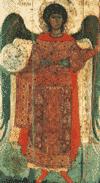- Vladimir-Suzdal school
-
School of Russian medieval mural and icon painting, with origins in Kievan Byzantine art, that flourished in the 12th–13th century around the cities of Vladimir and Suzdal, in northeastern Russia.Its works, while maintaining Byzantine illusionistic modeling and solid proportions that lack the elongation that characterizes all later Russian art, move toward a more Russian expression: the emotion is intensely ascetic, the anatomy of the figures is uncertain and the hands are typically small, and the facial expressions portray a range of emotions. This brilliant artistic development ended with the mid-13th-century Mongol invasions.
 "The Archangel Michael," icon by an anonymous artist of the Vladimir-Suzdal school, egg ...Novosti Press Agency, Moscow
"The Archangel Michael," icon by an anonymous artist of the Vladimir-Suzdal school, egg ...Novosti Press Agency, Moscow* * *
▪ Russian artschool of Russian (Russia) medieval mural and icon painting that flourished in the 12th and 13th centuries around the neighbouring cities of Vladimir and Suzdal in the Suzdal region of northeastern Russia. Vladimir-Suzdal, along with the city of Novgorod in northwestern Russia, was one of the two areas that inherited the Byzantine artistic traditions of Kiev, which lost preeminence to Vladimir in 1157. Like Kiev a centre of princely authority, Vladimir-Suzdal maintained great continuity with the monumental and aristocratic spirit of Kievan Byzantine art, producing works of exceptional quality.Stylistic similarities and a scarcity of documentation complicate the attribution of particular works to the Kievan or Vladimir-Suzdal schools. Impossible to dispute are frescoes that decorate the Suzdalian churches, including the Cathedrals of St. Dmitry and the Assumption in Vladimir, the Church of Saints Boris and Gleb in Kideksha, and Suzdal Cathedral. These fragments, the remains of work by Greek artists, depict aristocratic, dignified, classically featured figures painted with a confident impressionist technique. They maintain the delicate balance between the real and the ideal that characterizes Byzantine art and also betray a Russian intensity of emotion.Works of the Vladimir-Suzdal school, while preserving Byzantine illusionistic modeling and solid proportions that lack the elongation characterizing all later Russian art, move toward a more Russian expression: their emotion is intensely ascetic, the anatomy of the figures is uncertain and the hands typically small, and there is an increasingly conscious use of expressive colour. In addition, there is the use of facial expression to portray a variety of specific emotions that is the peculiar achievement of the Vladimir-Suzdal school.The brilliant artistic development of Vladimir-Suzdal was brought to a sudden end by the mid-13th-century invasions of the Mongols, who conquered all but northwestern Russia and destroyed countless treasures. The grand tradition of Kiev and Vladimir-Suzdal was thus lost, and the development of Russian art continued for the next 200 years along different lines, in the middle-class environment of Novgorod and its satellite city, Pskov. See also Novgorod school and Pskov school.* * *
Universalium. 2010.
